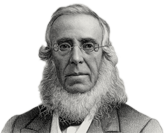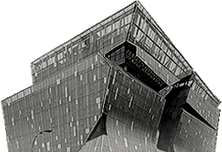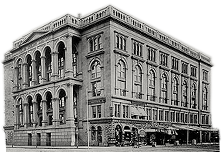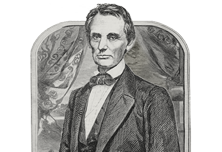2024-2025 Menschel Fellows
Corroso
This research-oriented project explores our understanding of objects in time by recognizing the agency of materials. This notion posits that materials possess inherent qualities and behaviors that influence how they are perceived, manipulated, and transformed, positioning them as active participants in the artistic process. The project, titled Corroso (Corroded), explores how corrosion can enhance the sensory qualities of glass, thereby transforming it into a dynamic contributor to the viewer's experience. Using acid, the project investigates the chemical corrosion of UltraClear Glass, known for being one of the most transparent types of glass available. It examines, conceptually and materially, the limitations of visibility inherent in such unique transparency. Through the degradation of the glass, Leopardi reveals a distinctive relationship with materiality, positioning both the material and the artist as equal participants in a transformative process where neither exerts dominance over the other. This exploration considers the artist's role as a facilitator in the transformation of materials, encouraging reflection on how the artist interacts with the material's processes. The project invites inquiry into how the interplay between artist and material shapes our perception of objects and their meanings in both historical and contemporary contexts. Ultimately, Leopardi encourages a rethinking of agency and ethics as part of a more inclusive and dynamic conception of existence through the complexities of collaboration between human and non-human agents.
Bio:
Chiara Leopardi’s investigation into the agency of matter arises from a deep concern for the role that materials play in shaping our experiences. Leopardi focuses on the degradation of materials as a means of revisiting and reinterpreting the past, engaging with artifacts to uncover their histories and inherent qualities. By examining how materials transform over time, Leopardi not only highlights their active participation in the artistic process but also invites viewers to reflect on the vitality embedded within these objects. This approach encourages a dialogue between the past and present, revealing how the physical state of materials can influence our understanding of history and memory.
Paradox/Dragline
Paradox/Dragline is a project developed from an interest in the mining and processing of phosphates in Bone Valley, Central Florida. Constructed from site visits conducted between June and July, the project culminated in a film (Will the surveyors envy the dead?, 2024) featuring shots of the wildlife and landscapes both natural and industrialized of the region. The research features a number of sample studies: water contaminated by cyanobacterial algae blooms stored in air-tight containers which fermented over time, tap water from my grandmother’s kitchen faucet, and fossilized rock and sand from active, unincorporated, and defunct phosphate mining sites; Riverview, Nichols, and Brewster. The project also serves as a meditation on the activities involved in delineating land areas, such as surveying and cartography.
Bio:
Zaid Arshad is a student in the School of Art, graduating 2025.
Desert of Absurdities
Our project focuses on the various models of human inhabitation of the desert throughout time. Human inhabitation of the desert has long been difficult due to the harsh environment. Prior to the industrial era, humans, like the various plants and animals of the desert, needed to “live alongside” the desert to persist within it. Through documentation and research of the indigenous Tohono O’odham tribe, we seek to reveal their movement patterns, restorative rituals to the desert, and various other networks of co-habitation with the desert and entities within the desert.
Our project also focuses on the exploration and documentation of the various sites of extraction in the desert and their effects on the surrounding environment. With the advent of industrialization, methods of extracting and transporting resources have improved exponentially, appeasing the previously unsustainable living condition of the desert and giving way to rapidly growing settlements and multiple experimental models of “living in” the desert. Our research documents the various successful and unsuccessful precedents of desert habitation, revealing their efficacy, their unforeseen drawbacks, as well as their absurdity.
Tying these two eras of living together is the unnegotiable requirement of essential resources: water, energy, and agriculture. Using these three resources as categorical lenses, our project seeks to comparatively analyze the pre-industrial co-habitation model of “living alongside” the desert and the post-industrial extraction model of “living in” the desert.
Bios:
Katherine Sazhin is a 3rd year architecture student at the Cooper Union. She is an active member of the student body, serving as treasurer of the Architecture Student Council. In this role, she helps manage the councils’ funds to organize schoolwide events. She also co-founded the AIAS chapter at the Cooper Union and serves as its vice president. As vice president, Katherine organized visits to architectural firms throughout the school year. This past summer, Katherine was a teaching assistant at The School of Architecture’s summer program for high school and college students, where she helped instruct 82 students from across the US and abroad on the fundamentals of design and thinking at the architectural scale.
Sophie Wang is a 4th year architecture student at the Cooper Union. She is skilled at various forms of fabrication and model-making, recently completing a ¼” – 1’ scale basswood model of her housing studio project, where she explored various forms of communal living and flexible boundaries for marginalized demographics. Sophie also participated in the fabrication and assembly of Shigeru Ban Architects’ Paper Log House exhibition on the Philip Johnson Estate alongside her classmates for her Building Tech course. This past summer, Sophie was an architect intern at NY interior architecture firm Architecture + Information (A+I). Here, she assisted with building Revit asset libraries, where she specialized on stair details. She also conducted initial site research as well as on-site detail inspection for multiple projects.
Daniel Luo is a 4th year architecture student at the Cooper Union. He serves as an Administrative Chair to the Architecture Student Council, also serving as its digital treasurer. In this role, Daniel acts as a liaison between the architecture student body and the administration across all three schools. During the semester, Daniel works at the IDC Foundation Art, Architecture, Construction, and Engineering (AACE) Laboratory as a student technician, offering support to all students at The Cooper Union on advanced fabrication and a variety of new digital fabrication tools. He also works at the Cooper Union Architecture Archive as a student archivist and photographer, where over this past summer he documented, photographed, and edited all 3rd year student work for NAAB accreditation.
Learning from Manoomin: The Architecture of Food Sovereignty
Learning from Manoomin: The Architecture of Food Sovereignty is a collaborative response to reading, travel, and conversation with community members from Bad River, Red Cliff, St. Croix, Oneida, Northwestern University, and University of Minnesota studying the power, life, and spirit of Manoomin, also known as “the good berry,” of the Ojibwe people. Aaliyah and Riley camped in Wisconsin for two weeks visiting cultural centers, meeting with tribal leaders, and attending community events to deepen their understanding of Manoomin and the vital life it provides the Ojibwe people and non-human relatives. One email led to another, and soon the students found themselves at a Bad River Rice Camp, being chased by excited children, eager to go ricing. Riley and Aaliyah were invited by a member of GLIFWC, Kathy Smith, to attend an informal inter-tribal meeting on Manoomin. They attended a Pow Wow, visited tribal farms, and went to a handful of tribal museums and libraries. The students collected craft objects, books, pamphlets, found objects (mostly trash), thousands of photographs, and priceless memories along their journey. The Spring 2025 exhibition will showcase models, drawing, collages, photographs, stories, research, quilts, and woven crafts to complement the primary source material. Both Aaliyah and Riley extend endless gratitude to Manoomin, the Bad River community, GLIFWC, Kathy Smith, Jodan Gurneau, Maddy Nyblade, and Lake Superior.
Bios
Aaliyah Torres is a fourth-year student in the School of Architecture born on Peoria, Potawatomi, Myaamia, Očhéthi Šakówiŋ, Hoocąk, Kaskaskia, and Kickapoo tribal land (Chicago, IL). With a strong interest in craft and textiles, they are interested in alternative modes of representation and methods of map-making. Aaliyah works with the Cooper Union Archives & Special Collections and is interested in the role archives and museums play in the recording and the reinforcing of Indigenous histories and sovereignty.
Gabriel Riley Howard is a white settler from the unceded Kickapoo, Kaskaskia, Myaamia, Peoria, Wyandot, and Erie tribal land of present-day Toledo, Ohio. He is a fifth-year architecture student studying trans embodiment and queer time through the means of representation and architectural theory. Through Learning from Manoomin: The Architecture of Food Soverignty, Gabriel is finding points of reference for a decolonial future, rooted in the past and present.
The Plant Doctor (植物醫師)
The Plant Doctor (植物醫師) is the result of our walks through fields of strawberries, betel nuts, chili peppers, and papayas, where we listened to farmers, local pesticide store owners, university professors, and plant doctors share their passions and perspectives on Taiwan’s agriculture. From weaving these conversations together construed Taiwan’s complex ecosystem - a land of lush fields determined through the joining of emerging professions and traditional agricultural practices.
Taiwan’s unsustainable monocultural farming has prolonged through a relationship between generational family farms and pesticide stores, which requires reshaping. Plant doctors were introduced with the hopeful vision of replacing pesticides to break free from agrochemicals and embrace nature’s homegrown pest repellents. The care that plants need is not a one-size-fits-all solution defined by a quick spray; it requires consistent effort in nurturing the soil, the seed, and the sapling, until it is matured for harvest. Sometimes, the answer can be as simple as inviting bees or natural predators to work their magic.
Plants may not talk or move, but we love attributing human-like traits to them—it’s charming, isn’t it? Yet when they fall ill, we cling to pesticides as our magic cure-all. It’s time to rethink pesticide-dependent monoculture and rework our attraction towards the fruit without a bug bite. This project invites its audience to recognize and imagine genuinely sustainable ways to nurture our green companions while celebrating the shared effort made by the modest yet expanding Plant Doctor community.
Bios
Ginger (Jingzhe) Fan grew up in Beijing, China. According to the Chinese agricultural calendar, she was born on the day when insects awaken—a fitting coincidence for someone inspired by nature, and most recently rainbows. Her work, often in the form of writing, video, and sculpture, invites thinking about predictions of inevitable scenarios, particularly in the context of natural disasters and frequency manipulation.
Evan Chiang is a current thesis architecture student at Cooper Union. He was born in the United States but grew up in Taiwan, the area of study for the Plant Doctor project. He works with photographic mediums including medium format film and is interested in ideas of projection and imaging within architecture. He has previously interned at Smith Miller + Hawkinson Architects, a small firm in New York City as well as Atelier Buffalo, a local architecture firm in the farmlands of Tainan, Taiwan. He hopes this upcoming exhibition will promote the unique challenges Taiwanese farmers face and bring forth his cultural upbringing as a Taiwanese.
Arthur Lee is a current thesis architecture student at the Cooper Union. He is currently interested in urban grassroot movements and agricultural practices through comparative studies. He works primarily through digital modeling and collaborative workshopping. He is currently working as an educator at the Saturday Program, collaborating on workshops with the Swiss Institute, and interning at the Loisaida Center.




